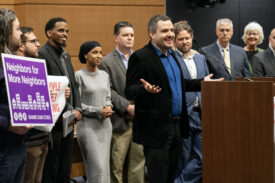Car crashes kill about 700 Washington residents each year. Now, remember, that’s out of a population of over 6.1 million—meaning that, on average, your chance of dying in a car crash this year is just over one in 10,000. With odds that slim, are collisions really such a big deal?
As far as I can tell, yes. Here’s why.
First there’s this: car crashes skew young. Surprisingly, motor vehicle accidents are the leading killer of Washingtonians between the ages of 1 and 44, reaching a peak between the ages of 15 and 24. Similarly, for those before retirement age, traffic deaths are third leading cause of shortened lifespans, trailing only cancer and heart disease. So the significance of traffic accidents to human health is far greater than the absolute numbers might suggest.
And then there’s this: For every traffic fatality, there are about 54 nonfatal traffic injuries and more than 200 collisions that cause no significant injury. And not only do those collisions take a toll in terms of pain and suffering, they’re really costly. According to the National Safety Council, you can get a pretty good estimate of the direct, out of pocket costs of traffic accidents by multiplying the number of traffic fatalities by $5.4 million dollars. (They estimate that this figure will cover medical costs, lost wages, property damage, and other direct, out-of-pocket costs resulting from collisions.) Using figures for 2002, that means that traffic accidents in the state of Washington were responsible for about $4 billion in direct economic costs.
But the real economic cost of collisions is probably even higher. The Safety Council estimates that each traffic fatality results on about $1 million in out of pocket costs, and each nonfatal injury, an average of $45,000. But these figures doesn’t account for pain and suffering, or how much people would be willing to pay to avoid a car crash.
Now, it’s always a bit creepy—and a lot controversial—to assign a dollar value to death or injury. But there’s no question that people don’t just consider medical costs and lost wages when they think about their own safety. The Federal Highway Administration estimates that, based on how much people are willing to pay to avoid dying in a car crash, a traffic fatality costs about $3.4 million in 2004 dollars (the figure in the link, $2.6 million, is in 1994 dollars; I adjusted for inflation). That figure is lower than that used by EPA, which assumes that people are willing to pay more than $6 million, on average, to avoid death.
Using these higher figures, the cost of car crashes escalates. Depending on the assumptions you use, the comprehensive cost of traffic collisions may top $8 billion annually, in Washington State alone.
Just by way of comparison, the Washington State Department of Transportation will spend about $1.7 billion per year (pdf link to budget document) over the next two years on highway maintenance, operations, and construction. Obviously, the state DOT doesn’t pay for all transportation expenses in the state. But it seems pretty certain that traffic accidents are far costlier than the roads on which they occur.








